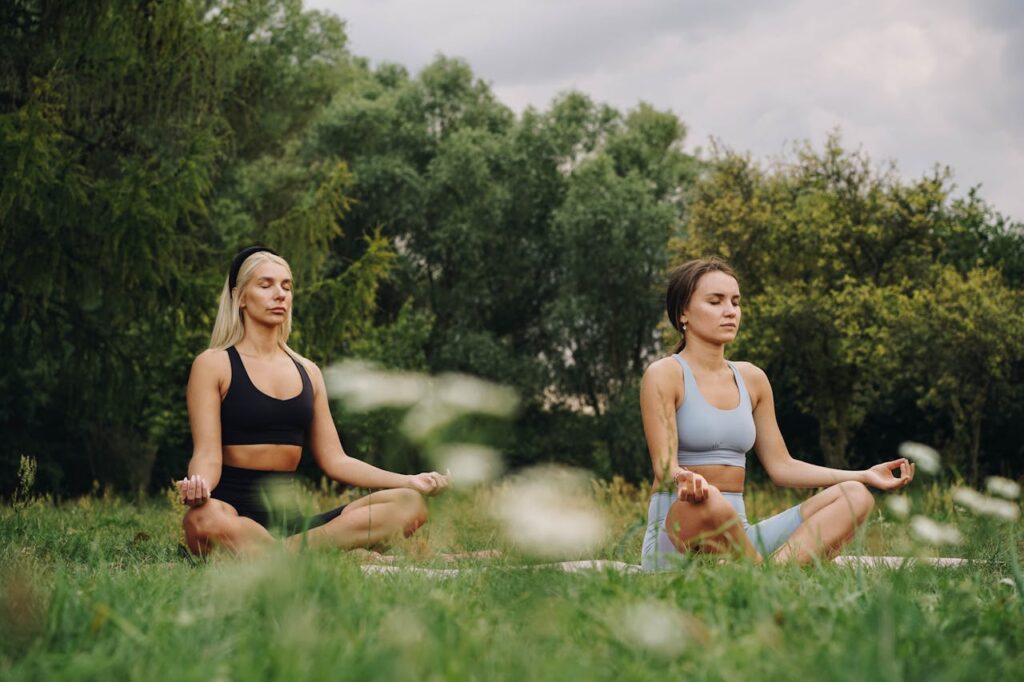Explore various meditation techniques and find encouragement for continued exploration and practice, leading you toward inner peace and self-discovery.
Introduction to Meditation Techniques
Understanding the Importance of Meditation
- Meditation is a practice that dates back centuries and holds significant importance in various cultures and traditions.
- It serves as a tool for cultivating inner peace, reducing stress, and promoting overall well-being.
- Through meditation, individuals can develop self-awareness, enhance concentration, and foster emotional resilience.
- Understanding the importance of meditation involves recognizing its profound effects on mental, emotional, and physical health.
Overview of Different Meditation Practices
- Meditation encompasses diverse techniques and approaches, each with a unique focus and benefits.
- Standard meditation practices include mindfulness, loving-kindness, transcendental, and mantra meditation.
- Each meditation practice emphasizes different aspects, such as breath awareness, visualization, or mantra repetition.
- Providing an overview of these practices enables individuals to explore various techniques and find one that resonates with their needs and preferences.
Benefits of Incorporating Meditation into Daily Routine
- Integrating meditation into daily routine offers many benefits that positively impact overall well-being.
- Regular meditation can reduce stress levels, lower blood pressure, and improve sleep quality.
- It enhances emotional regulation, promotes mental clarity, and fosters a greater sense of inner peace and contentment.
- Incorporating meditation into daily life cultivates resilience to life’s challenges and supports holistic health and wellness. Learn more.
Mindfulness Meditation
Definition and Principles of Mindfulness
- Mindfulness meditation is rooted in mindfulness, which involves non-judgmental awareness of the present moment.
- It emphasizes cultivating heightened awareness and attention to thoughts, sensations, and emotions as they arise.
- The principles of mindfulness meditation include acceptance, compassion, and detachment from the constant stream of thoughts.
- Practitioners learn to observe their experiences without clinging to or resisting them, fostering a sense of stability and inner peace.
Step-by-Step Guide to Mindfulness Meditation
- Begin by finding a comfortable seated position and bringing attention to the breath as it flows in and out.
- Notice sensations in the body sounds in the environment, and thoughts passing through the mind without judgment.
- When the mind wanders, gently guide attention back to the breath or present moment anchor, such as bodily sensations or sounds.
- Engage in mindful movement or body scan practices to deepen awareness and cultivate mindfulness in daily life.
Techniques to Enhance Mindfulness Practice
- Practice mindful breathing exercises, such as counting breaths or observing the rise and fall of the abdomen.
- Incorporate mindfulness into everyday activities, such as mindful eating, walking, or listening.
- Utilize guided mindfulness meditation recordings or smartphone apps to support and enhance your practice.
- Attend mindfulness meditation classes or workshops to learn from experienced teachers and connect with a supportive community. Learn more.
Breathing Techniques
Importance of Breath in Meditation
- Breath as the Foundation of Meditation: Understanding the crucial role of breath in various meditation practices.
- Enhancing Focus and Awareness: How conscious breathing cultivates mindfulness and deepens the meditation experience.
- Regulation of Stress Response: Exploring how controlled breathing techniques can calm the nervous system and reduce stress levels.
Deep Breathing Exercises
- Diaphragmatic Breathing: Step-by-step instructions for engaging the diaphragm and promoting deep, abdominal breaths.
- Box Breathing Technique: Understanding the 4-4-4-4 breathing pattern and its effectiveness in promoting relaxation.
- Alternate Nostril Breathing: Exploring the balancing effects of this pranayama technique on the mind and body.
Pranayama Techniques from Yoga
- Anulom Vilom (Nadi Shodhana): Understanding the cleansing and balancing effects of this alternate nostril breathing technique.
- Kapalabhati Pranayama: Exploring the energizing and purifying benefits of rapid, forceful exhalations followed by passive inhalations.
- Ujjayi Breath: Learning the oceanic breath technique to enhance focus, concentration, and internal heat during meditation. Learn more.

Guided Visualization
Understanding Guided Visualization
- Definition and Purpose: Exploring the concept of guided visualization as a form of meditation that utilizes mental imagery.
- Accessing the Subconscious Mind: Understanding how guided visualization can tap into the power of the subconscious for healing and transformation.
- Facilitating Relaxation and Stress Relief: Discuss how guided visualization induces deep relaxation, promoting mental and emotional well-being.
How to Practice Guided Visualization Meditation
- Preparation: Creating a conducive environment for meditation, including comfortable seating and minimal distractions.
- Guided Imagery Script: Following a guided meditation script or audio recording to lead the mind through a visual journey.
- Engagement and Surrender: Balancing active participation with surrendering to the experience allows the visualization to unfold naturally.
Creating Personalized Visualization Scripts
- We are identifying Goals and Intentions: Reflecting on personal aspirations and desired outcomes to tailor visualization scripts accordingly.
- We are incorporating Sensory Details, vivid imagery, and sensory cues to enhance the realism and effectiveness of the visualization.
- Recording and Revisiting: Recording personalized scripts for future use and modifying them to align with evolving needs and goals. Learn more.
Body Scan Meditation
Exploring the Body Scan Technique
- Body scan meditation involves systematically focusing on different parts of the body, from head to toe, to cultivate awareness and relaxation.
- Individuals can release tension, improve body awareness, and promote overall relaxation by bringing attention to each body part.
Step-by-Step Instructions for Body Scan Meditation
Find a comfortable position: Sit or lie comfortably, ensuring your body is supported and relaxed.
Begin with awareness: Close your eyes and focus on your breath, taking a few deep breaths to center yourself.
Start scanning: Slowly shift your focus to different body parts, starting from the top of your head and moving down to your toes.
Notice sensations: As you focus on each body part, observe any sensations you may feel, such as warmth, tension, or tingling.
Release tension: If you encounter any tension or discomfort, consciously relax those muscles and let go of any stress or tightness.
Stay present: Maintain your awareness of each body part as you scan through, allowing yourself to be fully present in the moment.
Conclude with gratitude: Once you’ve scanned your entire body, take a few moments to express gratitude for your body and the experience of relaxation.
Benefits and Applications of Body Scan in Meditation
- Stress reduction: Body scan meditation helps to release physical tension and promote relaxation, reducing stress levels.
- Improved body awareness: Practicing body scans regularly enhances awareness of bodily sensations, aiding in better self-regulation and mindfulness.
- Enhanced concentration: Individuals can improve their concentration and mental clarity by focusing on each body part.
- Better sleep quality: Body scan meditation before bedtime can relax the body and mind, improving sleep quality and more profound rest. Learn more.
Loving-Kindness Meditation
Concept of Loving-Kindness (Metta) Meditation
- Loving-kindness meditation, also known as Metta meditation, cultivates love, compassion, and goodwill towards oneself and others.
- Rooted in Buddhist tradition, Metta meditation involves silently repeating phrases of loving-kindness to oneself and extending it to others.
Practice Guidelines for Loving-Kindness Meditation
- Find a quiet space: Choose a peaceful, comfortable space to sit or lie down without distractions.
- Set intentions: Begin by setting your intention for the practice, focusing on cultivating feelings of love, compassion, and kindness.
- Repeat phrases: Start by directing loving-kindness towards yourself, silently repeating phrases such as “May I be happy, may I be healthy, may I be safe, may I live with ease.”
- Extend to others: Gradually extend the loving-kindness to others, starting with loved ones, then acquaintances, and eventually all beings.
- Embrace challenges: If you encounter resistance or difficulty during the practice, approach it gently and patiently, acknowledging any emotions that arise.
- Practice regularly: Engage in loving-kindness meditation regularly to cultivate a genuine sense of compassion and empathy towards oneself and others.
Cultivating Compassion and Empathy through Metta Practice
- Increased empathy: Loving-kindness meditation fosters empathy by encouraging individuals to recognize and connect with the shared human experience of suffering and joy.
- Strengthened relationships: By cultivating feelings of love and compassion, Metta meditation can improve relationships and enhance interpersonal connections.
- Self-compassion: Regular loving-kindness meditation nurtures self-compassion, fostering a sense of kindness and acceptance towards oneself.
- Emotional resilience: Metta practice equips individuals with emotional resilience, enabling them to respond to challenges with compassion and understanding. Learn more.
Mantra Meditation
Introduction to Mantra Meditation
Mantra meditation is a profound technique that involves repeating a word, phrase, or sound to focus the mind and cultivate inner peace. Rooted in ancient traditions such as Hinduism and Buddhism, mantra meditation has gained popularity worldwide for its simplicity and effectiveness in quieting the mind. By engaging with a mantra, practitioners can transcend mundane thoughts and enter a state of heightened awareness and tranquility.
- Origins and History of Mantra Meditation: Explore mantra meditation’s rich cultural and spiritual heritage, tracing its roots to ancient Eastern philosophies and traditions.
- The Power of Sound: Delve into the significance of sound vibrations in mantra meditation, understanding how specific sounds resonate with the mind and body to induce a meditative state.
- Scientific Insights: Examine modern research findings that validate the benefits of mantra meditation, including its ability to reduce stress, enhance concentration, and promote emotional well-being.
Choosing a Mantra and its Significance
Selecting the right mantra is essential for a meaningful and effective meditation practice. Whether drawn from religious texts, spiritual traditions, or personal intuition, each mantra carries its unique vibration and significance. Understanding the meaning and resonance of a chosen mantra can deepen the meditative experience and foster a stronger connection to one’s inner self.
- Types of Mantras: Explore different categories of mantras, including sacred chants, affirmations, and traditional Sanskrit verses, and their respective purposes in meditation.
- Personalization and Intuition: Discuss the importance of selecting a mantra that resonates personally with the practitioner, emphasizing the role of intuition and inner guidance in the process.
- Symbolism and Intent: Examine the symbolic significance of specific mantras and their alignment with the practitioner’s intentions, goals, and spiritual beliefs.
Incorporating Mantra Meditation into Daily Routine
Integrating mantra meditation into daily life offers a pathway to sustained inner peace and spiritual growth. By establishing a consistent practice, individuals can harness the transformative power of mantras to navigate life’s challenges with clarity, resilience, and presence.
- Creating a Sacred Space: Guide practitioners in setting up a dedicated meditation space conducive to mantra practice, incorporating elements such as comfortable seating, ambient lighting, and meaningful objects.
- Establishing Rituals and Routines: Provide practical tips for incorporating mantra meditation into daily routines, including morning rituals, midday breaks, and bedtime practices, to cultivate mindfulness and balance throughout the day.
- Cultivating Mindfulness in Action: Emphasize the integration of mantra meditation beyond formal sitting sessions, encouraging practitioners to infuse everyday activities with mindful awareness and intentionality. Learn more.
Movement-Based Techniques
Tai Chi and Qigong for Meditation
Tai Chi and Qigong offer dynamic movement-based approaches to meditation, blending flowing sequences of postures, breathwork, and mindfulness principles. Originating from ancient Chinese martial arts and healing traditions, these practices promote physical health, emotional well-being, and spiritual cultivation through gentle, deliberate movements.
- Principles of Tai Chi and Qigong: Explore the foundational principles underlying Tai Chi and Qigong, including the concept of Qi (life energy), Yin-Yang balance, and the interconnectedness of mind, body, and spirit.
- Flowing Movements and Breath Awareness: Highlight the rhythmic, fluid movements of Tai Chi and Qigong forms, synchronized with deep, conscious breathing to promote relaxation, vitality, and inner harmony.
- Meditation in Motion: Describe how Tai Chi and Qigong serve as moving meditations, fostering a state of mindful awareness and presence as practitioners flow seamlessly through sequences of movements.
Walking Meditation: Steps and Benefits
Walking meditation offers a dynamic alternative to traditional seated practices, inviting practitioners to cultivate mindfulness and presence while in motion. Whether practiced indoors or outdoors, walking meditation encourages a deeper connection to the body, breath, and surroundings, fostering a sense of groundedness and tranquility amidst the rhythms of walking.
- Mindful Walking Techniques: Introduce various approaches to walking meditation, including slow walking, walking with breath awareness, and mindful walking in nature, each offering unique benefits and experiences.
- Sensory Awareness and Grounding: Guide practitioners in attuning to the sensory experiences of walking, such as the sensation of the feet touching the ground, the rhythm of breath, and the sights and sounds of the environment.
- Benefits of Walking Meditation: Discuss the physical, mental, and emotional benefits of walking meditation, including stress reduction, improved concentration, enhanced mood, and heightened sensory perception.
Incorporating Movement into Stillness for Enhanced Focus
Integrating movement and stillness in meditation can deepen concentration, embodiment, and inner awareness. By incorporating gentle movement practices into seated meditation sessions, practitioners can release tension, promote circulation, and cultivate a grounded presence, enhancing overall mindfulness and focus.
- Dynamic Body Awareness Techniques: Introduce gentle movement exercises, such as mindful stretching, body scans, and spontaneous movement explorations, to awaken awareness of bodily sensations and release muscular tension.
- Embodied Breathwork: Explore the integration of breath awareness with movement, incorporating synchronized breath cycles with gentle stretches or flowing motions to enhance breath-body connection and relaxation.
- Flowing between Movement and Stillness: Guide practitioners in seamlessly transitioning between active movement and seated stillness within a meditation session, allowing for a fluid exploration of inner and outer experiences.
Building a Sustainable Meditation Practice
Setting Realistic Goals and Expectations
- Begin by identifying specific outcomes you wish to achieve through meditation.
- Break down larger goals into smaller, achievable milestones.
- Acknowledge that progress may vary, and be patient with yourself.
- Adjust goals as needed to reflect your evolving meditation journey.
Creating a Consistent Schedule for Meditation
- Allocate dedicated time each day for meditation, considering your schedule and preferences.
- Experiment with different times of day to find what works best for you.
- Incorporate meditation into your routine by linking it with existing habits, such as before bed or after waking up.
- Utilize reminders or alarms to help establish and maintain your meditation schedule.
Integrating Mindfulness into Daily Activities
- Practice mindfulness during routine tasks, such as eating, walking, or commuting.
- Cultivate awareness of the present moment by focusing on sensations, thoughts, and emotions as they arise.
- Use everyday experiences as opportunities for mindfulness practice, such as mindful breathing during stressful situations.
- Gradually expand mindfulness beyond formal meditation sessions to enhance overall presence and awareness in daily life.

Final words
Encouragement for Continued Exploration and Practice
- Emphasize the importance of ongoing exploration and experimentation with different meditation techniques.
- Encourage resilience in the face of challenges and setbacks, viewing them as opportunities for growth.
- Highlight the transformative potential of consistent meditation in fostering overall well-being and inner peace.
Final Thoughts on Achieving Inner Peace through Meditation
- Reflect on the profound impact of meditation on promoting inner peace, resilience, and emotional balance.
- Stress the role of meditation as a lifelong journey of self-discovery and personal growth.
- Express confidence in the reader’s ability to cultivate greater peace and fulfillment through continued dedication to meditation practice.
- Enlightenment Awaits Ome’s Premier Ayahuasca Retreat in the USA. Learn more.
- 7 Best Ayahuasca Retreats in America (Updated 2024). Learn more.
- Explore OME’s Spiritual Healing & Ayahuasca Retreats in California. Learn more.
- Welcome to OME’s Spiritual Healing & Ayahuasca Retreats in Georgia. Learn more.
- Discover OME’s Ayahuasca Retreats in Atlanta, GA. Learn more.
- Join Our Ayahuasca Retreats in Texas. Learn more.
- Join Our Ayahuasca Retreats in Florida. Learn more.
- Join Our Ayahuasca Retreats in Rhode Island, USA. Learn more.
- Join Our Ayahuasca Retreats in Maryland. Learn more.
- Join Our Ayahuasca Retreats in Delaware. Learn more.
- Join Our Ayahuasca Retreats in Connecticut, USA. Learn more.
- 7 Best Ayahuasca Retreats in America (Updated 2024). Learn more.
- Join Our Ayahuasca Retreats in Massachusetts, USA. Learn more.
- Discover OME’s Ayahuasca Retreats in New Jersey. Learn more.
- Join Our Ayahuasca Retreats in New Hampshire, USA. Learn more.
- Join Our Ayahuasca Retreats in Pennsylvania, USA. Learn more.
- Join Our Ayahuasca Retreats in New York. Learn more.



